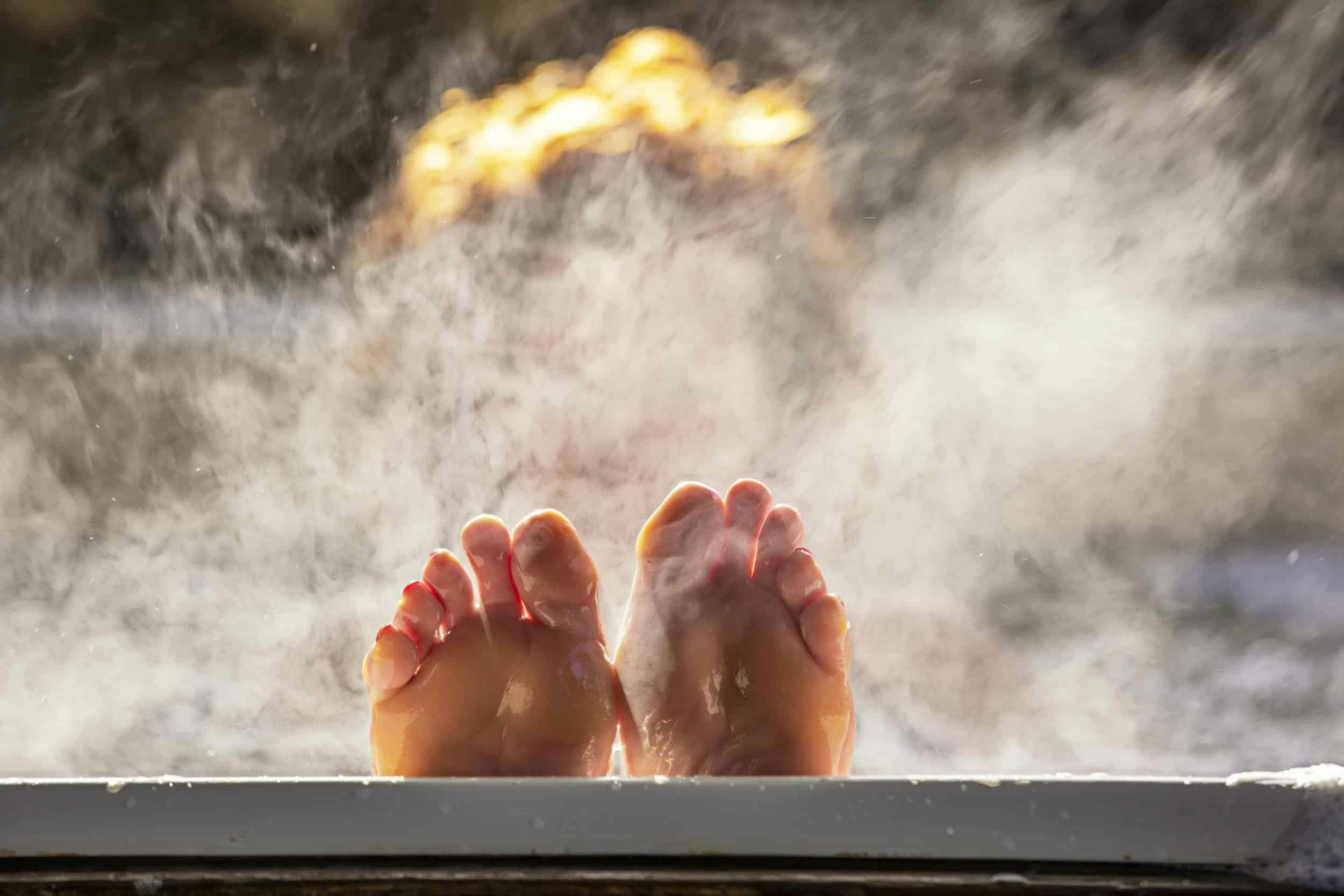Some Like it Hot: Healing Hot Springs across the British Isles
3 February 2023
Healing hot springs have worked wonders for centuries, and some are much closer than you think…
Enjoyed across the world for thousands of years thanks to their warmth and suspected medicinal properties, hot springs offer people an indulgent way to reconnect with the great outdoors. While many of the world’s most loved hot spring spots are in far-flung locations, such as Iceland’s Blue Lagoon or Dunton Hot Springs in Colorado, Britain itself boasts a number of thermal waters to make the most of, from Bath to Buxton and beyond. Originating in ancient Japanese, Roman and Greek cultures, bathing has long been considered a gift of the divinity and a magic cure for many diseases. The health benefits of bathing in a hot spring are well-documented, with the high mineral content of iron, sulphate, zinc, magnesium, silica, calcium, and potassium being shown to help skin conditions such as psoriasis, acne and eczema, while also being attributed to help with circulation and even boost metabolism. What’s more, bathing in hot springs can even offer temporary pain relief with recent scientific studies showing that soaking in mineral-rich waters can block pain receptors, making bathing a potentially life-changing experience. For these reasons and more, people continue to flock to the world’s best hot springs, with many being closer to home than you might think.
Bath, Somerset
The most famous of Britain’s hot springs can be found in the historic city of Bath, a destination whose popularity dates as far back as Roman times for its magical waters. As well as being the most renowned baths in Britain, Bath’s waters are also some of the hottest, reaching temperatures of 45-46°C - a full 15°C over the average temperature.
Thought to have been formed between 200,000 and 500,000 years ago, Bath’s hot springs are comprised of a mixture of rock formations that are both prone to cracking and highly permeable, which allow water to slowly flow through, while picking up 43 precious minerals and significant heat along the way. The three main springs, only 150m apart from one another in distance, are named the King’s Spring, the Hetling Spring and the Cross Bath Spring, displacing a total of 1,250,000 litres of water per day, or 15 litres per second.
While Bath’s springs boast an intriguing ancient origin legend, of Prince Bladud curing his leprosy and that of his pet pigs in the waters, the true history to Bath’s famous springs is slightly more unclear. The first archaeological activity around the once-hidden hot springs dates back to 8000 BC, with coins from the Iron Ages having been found in the local area.
Assumed to have had the appearance of steam appearing from a swamp and possibly too mysterious for humans to fully seek out, it was the arrival of the Romans that transformed the springs into the historical city we know today. While history surrounding the waters is suitably muddy, it’s presumed that the Romans settled at Bath around a pre-existing Celtic temple dedicated to the goddess Sulis, and their arrival saw the springs transformed into the grand Aquae Sullis site we know today. Since the baths were transformed into a much larger bathing complex for Romans to enjoy, they have taken on many different roles throughout the years. Often prescribed by doctors and physicians as a cure-all for many skin conditions, gout, rheumatism and sciatica, the popularity of Bath’s waters remained strong until the 20th century, where they now sit as a restored historical site and are an important part of the local and tourist culture for the city.
Those looking to experience Bath’s magical hot springs can visit the Thermae Spa nearby, which receives the thermal waters from the three hot springs and has incredible views across the city from its rooftop area.
Where to stay: Found on the iconic Royal Crescent with its famous curve of Georgian architecture, step back in time with a stay at The Royal Crescent Hotel & Spa. Moments away from the ancient Roman Baths and the centre of the UNESCO World Heritage Site of Bath, enjoy the finest art, gardens and more at this incredible Grade I listed building.

Buxton, The Peak District
While Bath may be the most famous of them all, there are also some incredible hot springs in every corner of Britain. Tucked away in the Peak District, Buxton’s thermal waters reach an impressive 28°C and were once known by the Roman name of Aquae Arnemetiae, the only town outside of Bath to have the prestigious ‘Aquae’ distinction in its name.
Buxton’s mineral waters have had many notable visitors over the years, with one infamous royal family member being Mary Queen of Scots who, as a prisoner, was thought to have been moved around the country by her cousin Elizabeth I for her own safety. With the request for Mary to take in the healing magnesium-rich waters of Buxton being accepted, she visited regularly for 11 years in order to help her rheumatism. Having previously been closed by Henry VIII, Buxton’s hot spring was reopened with the addition of a building erected to guard Mary from potential threats.
Later the town became a key attraction in the 18th century for health pilgrimages alongside other spa destinations around the UK, such as Cheltenham, Harrogate, Matlock and more.
Other nearby hot springs: Moving down towards the West Midlands, Droitwich Spa’s natural hot springs are packed with mineral salt, making it ten times saltier than seawater. Britain’s answer to the Dead Sea, this water has been popular for many years for its supposed healing powers when it comes to curing many diseases, helping to restore tired muscles and even as a remedy for fatigue.
Harrogate, Yorkshire
Around 80-100 springs are thought to run through the Yorkshire spa town of Harrogate, with each spring having a slightly different mineral composition, making it the ideal spot for treating a range of medical conditions.
Following the discovery of the springs in ‘High Harrogate’ in the 16th century, the town’s popularity was catapulted with the discovery of sulphur-rich springs in ‘Low Harrogate’ later in the century. While locals were able to venture into the spring’s original marshy areas to scoop up the water, many guests including Royal family members flocked to the Yorkshire town to ‘take in the waters’ and made Harrogate Britain’s most upmarket hotspot.
With the town becoming a fashionable place to bathe from the late 16th century, visitors came from across Europe to enjoy its many healing properties. It was highly common for doctors and physicians to prescribe these visits as a genuine cure for skin ailments, scurvy, epilepsy, rheumatism and even melancholy. Enjoying its own ‘season’ across the summer months, wealthy aristocrats could sample the hot springs through bathing or with glasses of sulphur-rich water to drink throughout the day, offering a real taste of the thermal waters located nearby.
Where to stay: While it was fashionable in the 1800s to drink two glasses of Harrogate’s mineral water before breakfast, we’d recommend swapping sulphur for a stay at Grantley Hall. Located in nearby Ripon, guests can explore the historic spa town of Harrogate and the stunning Yorkshire Dales before relaxing in the opulent interiors at this grand country house.
Did you know?
Only the grand Turkish Baths remain at the site of the Royal Baths, and this remains largely untouched since the Victorian times and is the perfect spot to enjoy a slice of history. While Harrogate was a favourite of the rich and famous, a free tap was placed on the outside of the main building to supply the sulphur waters to all, including the poorest in society. You can still find it there today, just make sure to not drink it.
Related Content
More Stories
Flavour & Savour
A Rather Refined Veganuary: Garden-Led Plates & Plant-Forward Pleasure
22 December 2025
Discover a fresh take on Veganuary with creative plant-led dishes, spa soaks and hotels that make eating green feel effortlessly glamorous.
Flavour & Savour
Zero Proof and Fully Fabulous: Elegant British Mocktails for a Refined New Year
19 December 2025
Start your year with drinks so delicious you’ll forget they’re alcohol-free. Created by the brilliant bartenders of some of Britain’s loveliest hotels, these beautifully crafted mocktails deliver all the glamour with none of the regret.
Behind the Door
Life on the Land: In Conversation with Fergus MacLeod of the Fife Arms Ghillie Team
17 December 2025
As part of the Ghillie team at The Fife Arms, Fergus MacLeod helps guests discover the wild beauty and stories of Royal Deeside. Through guided walks, off-road journeys and time spent immersed in the landscape, he creates experiences shaped by …








